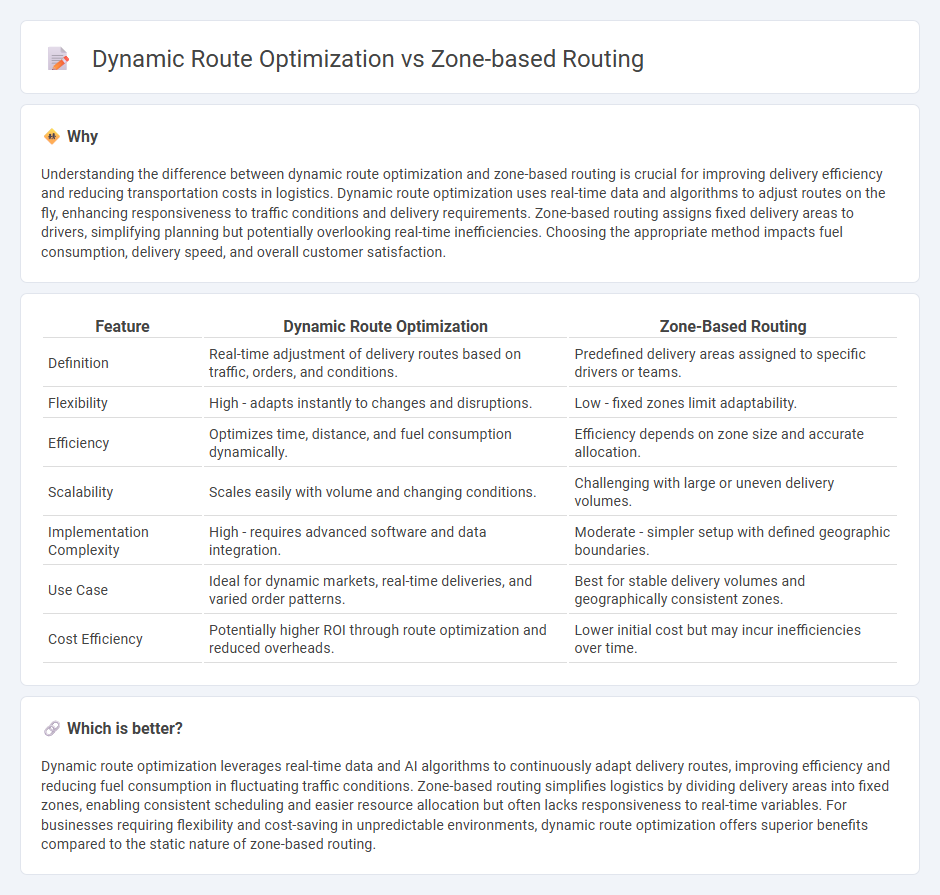
Dynamic route optimization leverages real-time data and advanced algorithms to continuously adjust delivery routes for maximum efficiency, reducing fuel consumption and improving delivery times. Zone-based routing segments delivery areas into fixed zones, simplifying route planning but potentially overlooking real-time traffic conditions and demand fluctuations. Explore how dynamic route optimization outperforms zone-based routing in logistics by enhancing operational agility and customer satisfaction.
Why it is important
Understanding the difference between dynamic route optimization and zone-based routing is crucial for improving delivery efficiency and reducing transportation costs in logistics. Dynamic route optimization uses real-time data and algorithms to adjust routes on the fly, enhancing responsiveness to traffic conditions and delivery requirements. Zone-based routing assigns fixed delivery areas to drivers, simplifying planning but potentially overlooking real-time inefficiencies. Choosing the appropriate method impacts fuel consumption, delivery speed, and overall customer satisfaction.
Comparison Table
| Feature | Dynamic Route Optimization | Zone-Based Routing |
|---|---|---|
| Definition | Real-time adjustment of delivery routes based on traffic, orders, and conditions. | Predefined delivery areas assigned to specific drivers or teams. |
| Flexibility | High - adapts instantly to changes and disruptions. | Low - fixed zones limit adaptability. |
| Efficiency | Optimizes time, distance, and fuel consumption dynamically. | Efficiency depends on zone size and accurate allocation. |
| Scalability | Scales easily with volume and changing conditions. | Challenging with large or uneven delivery volumes. |
| Implementation Complexity | High - requires advanced software and data integration. | Moderate - simpler setup with defined geographic boundaries. |
| Use Case | Ideal for dynamic markets, real-time deliveries, and varied order patterns. | Best for stable delivery volumes and geographically consistent zones. |
| Cost Efficiency | Potentially higher ROI through route optimization and reduced overheads. | Lower initial cost but may incur inefficiencies over time. |
Which is better?
Dynamic route optimization leverages real-time data and AI algorithms to continuously adapt delivery routes, improving efficiency and reducing fuel consumption in fluctuating traffic conditions. Zone-based routing simplifies logistics by dividing delivery areas into fixed zones, enabling consistent scheduling and easier resource allocation but often lacks responsiveness to real-time variables. For businesses requiring flexibility and cost-saving in unpredictable environments, dynamic route optimization offers superior benefits compared to the static nature of zone-based routing.
Connection
Dynamic route optimization leverages real-time data and algorithms to continuously adjust delivery routes for efficiency, while zone-based routing segments service areas into specific zones to streamline distribution. The connection lies in using zone-based routing as a structural framework within which dynamic route optimization operates, enhancing route accuracy and reducing delivery times. This integration results in improved resource allocation, reduced fuel consumption, and increased overall logistics performance.
Key Terms
**Zone-based routing:**
Zone-based routing segments a network into security zones, enabling policy enforcement and traffic control between these distinct areas to enhance security and manageability. This method simplifies network configuration by applying rules based on zone membership rather than individual interfaces, improving scalability and administrative efficiency. Discover how zone-based routing can streamline your network security strategy and optimize traffic management.
Geographic segmentation
Zone-based routing divides delivery areas into fixed geographic segments to streamline logistics and reduce travel distances within each zone. Dynamic route optimization continuously analyzes real-time data such as traffic, weather, and delivery urgency to adjust routes dynamically for maximum efficiency. Discover how leveraging geographic segmentation versus adaptive routing can enhance your supply chain strategy.
Fixed routes
Zone-based routing segments delivery areas into predefined zones to improve fixed route management by simplifying dispatch and reducing travel time within each zone. Dynamic route optimization adapts routes in real-time based on traffic, delivery changes, or other variables, offering greater flexibility but less predictability in fixed route systems. Explore more to understand which routing strategy best enhances efficiency and customer satisfaction for fixed-route logistics.
Source and External Links
Easing into a Dynamic Operation With Zone-Based Routing - Zone-based routing divides geographic areas into zones each serviced by a dedicated driver, enabling efficient static or dynamic routing in last-mile delivery operations by aligning routes with driver territories and business rules.
Zone-Based Routing - Zone-based routing assigns leads or deals to specific representatives or managers based on geographic or industry zones to ensure local expertise and prompt customer response, often integrated with CRM systems for automation.
Understand the Zone-Based Policy Firewall Design - In network security, zone-based routing defines network zones that act as security boundaries where traffic crossing between zones is managed by defined policies to apply access controls and filtering.
 dowidth.com
dowidth.com